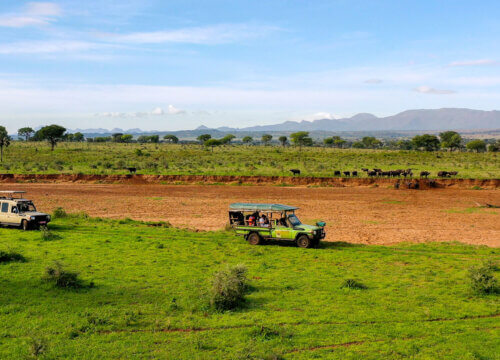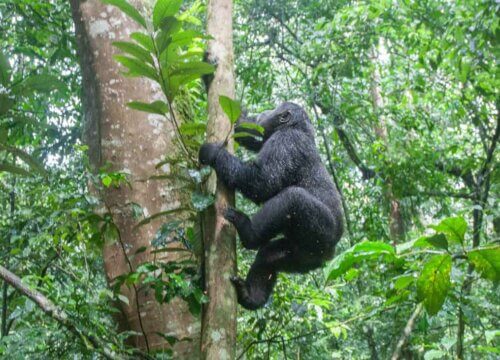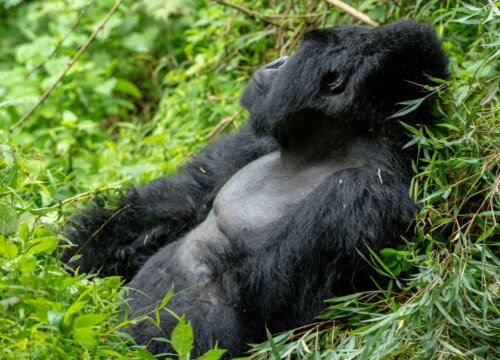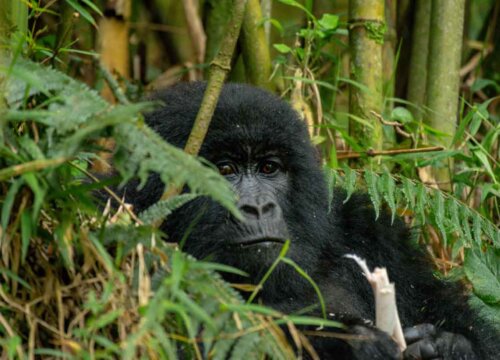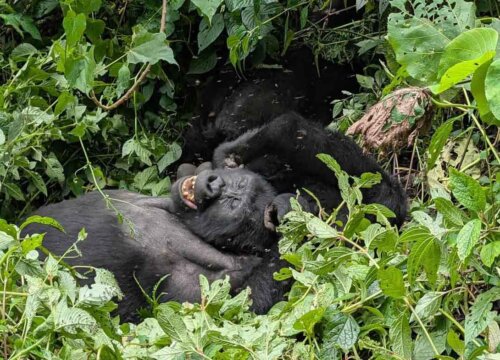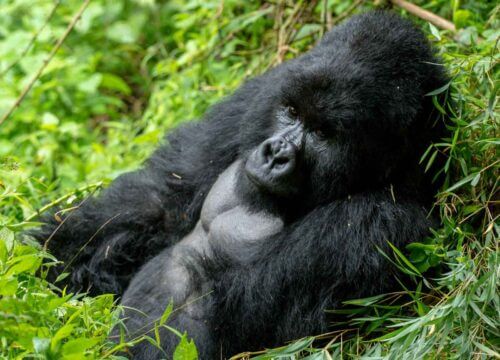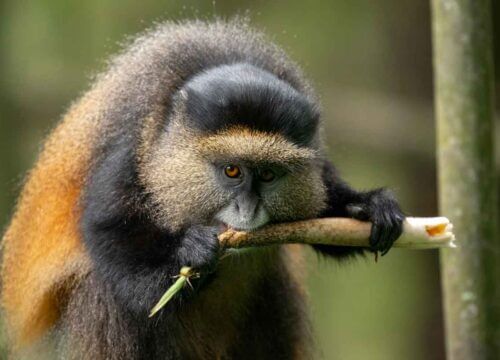Why are mountain gorillas in Rwanda and Uganda endangered?
Why are mountain gorillas in Rwanda and Uganda endangered?
Mountain gorillas, found in the lush forests of Rwanda and Uganda are truly magnificent creatures. However, despite their strength and adaptability, these gentle giants are considered endangered. Their population has faced significant challenges over the years due to a combination of human activities and environmental factors. Let us take a closer look at some of the key reasons behind their endangered status.
One of the main threats to mountain gorillas is habitat loss. The forests they call home are often cleared for agriculture, logging and human settlement. As human populations grow, the demand for land increases, pushing gorillas into smaller and more fragmented habitats. This not only limits their space to roam and find food but also isolates groups, reducing genetic diversity and making them more vulnerable to diseases.
Speaking of diseases, mountain gorillas are highly susceptible to illnesses transmitted by humans. Because they share about 98% of their DNA with us, they can catch diseases like the flu or respiratory infections which can be deadly for them. With increased tourism and human activity in their habitats, the risk of disease transmission has grown significantly.
Poaching is another serious issue that has historically impacted mountain gorilla populations in Rwanda and Uganda. Although hunting these animals is now illegal, they are sometimes caught in snares set for other wildlife. These traps can cause severe injuries or even death. Additionally, in the past, baby gorillas were targeted for the illegal pet trade, often resulting in the death of their protective families.
Climate change is also playing a role in threatening mountain gorillas. Altered weather patterns can affect the availability of food and water in their habitats. For instance, changes in rainfall can disrupt the growth of plants that gorillas rely on for sustenance, making it harder for them to find enough to eat.
Despite these challenges, there is hope for mountain gorillas. Conservation efforts led by governments, local communities and organizations have made a significant impact. Initiatives like anti-poaching patrols, habitat restoration projects, and responsible eco-tourism have helped stabilize and even increase their population in recent years. Education and awareness campaigns have also encouraged local communities to protect mountain gorillas.
While mountain gorillas still face many threats, their story is one of resilience and determination. With continued effort and care, we can ensure that future generations will have the privilege of witnessing these majestic creatures thriving in the wild.
Mountain Gorilla Conservation in Rwanda and Uganda
Rwanda and Uganda have emerged as leaders in mountain gorilla conservation. Both countries have established protected areas like Volcanoes National Park in Rwanda and Bwindi Impenetrable National Park in Uganda. These parks serve as safe havens for mountain gorillas and provide a sanctuary where they can thrive. Local communities are also playing a crucial role. Through eco-tourism programs, locals are employed as guides, trackers and conservationists, creating an economic incentive to protect these magnificent animals.
Gorilla trekking has become an exciting experience for many travelers. Small groups of visitors are allowed to trek into the forests to observe these primates up close. This not only raises awareness but also generates significant revenue for conservation programs. A portion of the fees collected goes directly toward protecting the gorillas and supporting local communities. It is a win-win model that highlights how tourism can be a force for good.
The story of mountain gorilla conservation in Rwanda and Uganda is one of hope and perseverance. It reminds us that with collective effort, even the most vulnerable species can have a fighting chance. Whether you are planning a visit to see these incredible creatures or simply supporting conservation efforts from afar, every action makes a difference.
How to overcome threats to mountain gorillas in Rwanda and Uganda
Mountain gorillas face numerous threats that endanger their survival. From habitat destruction to poaching and disease, the challenges are real but there is hope. Together, we can take steps to protect these incredible animals and ensure they thrive for generations to come. Let us explore some of the key threats to mountain gorillas and practical ways we can overcome them.
Protecting gorilla habitats. One of the most significant threats to mountain gorillas is habitat loss. As human populations grow, forests are often cleared for agriculture, settlements or infrastructure development. This encroachment reduces the space available for gorillas and disrupts their natural environment. Governments and conservation organizations can work together to expand and enforce protected areas like national parks. In Rwanda, the Volcanoes National Park is a safe haven for mountain gorillas while in Uganda, Bwindi Impenetrable National Park provides critical shelter.
Promote sustainable land use. Encouraging sustainable farming practices and offering alternative livelihoods to local communities can reduce the pressure on forested areas. Planting native trees in degraded areas also helps restore mountain gorilla habitats and increases food availability for them.
Combat Poaching. Poaching has long been a threat to mountain gorillas. While direct hunting of mountain gorillas has decreased thanks to conservation efforts, they are still at risk from snares set for other animals. These traps can injure or even kill mountain gorillas unintentionally. Rwanda and Uganda governments should increase anti-poaching patrols. Trained rangers and surveillance teams play a crucial role in protecting mountain gorillas from poachers.
Educating local communities about the importance of mountain gorillas to the ecosystem and their potential as a source of eco-tourism income can also discourage poaching.
Prevent disease transmission. Mountain gorillas share about 98% of their DNA with humans making them highly susceptible to human diseases. Even a common cold can have devastating effects on a mountain gorilla population. The increasing interaction between humans and mountain gorillas, particularly through tourism heightens this risk. Tourists should maintain a safe distance from the animals, wear masks and follow strict hygiene guidelines. Regular health checks for both gorillas and park staff can also help identify and address potential outbreaks early.
Engage local communities. Local communities play a central role in the conservation of mountain gorillas. Without their support, long-term efforts are unlikely to succeed. However, poverty and lack of resources often push people towards activities that harm mountain gorillas such as illegal logging or poaching.
Promoting responsible tourism. Tourism is a double-edged sword when it comes to mountain gorilla conservation. On one hand, it generates much-needed funds for conservation efforts. on the other hand, it can disturb the animals if not managed properly. Limit visitor numbers on daily to minimize stress on mountain gorillas and reduce the risk of disease transmission. Tourists should also choose tour companies like Giant Holiday Safaris that prioritize conservation and adhere to guidelines set by park authorities.
Global support for conservation. The survival of mountain gorillas is not just a regional issue, it is a global one. These creatures are part of our shared natural heritage and protecting them requires international collaboration. Support conservation organizations like the Dian Fossey Gorilla Fund and the International Gorilla Conservation Programme that work tirelessly to protect mountain gorillas. Donations, volunteering or simply spreading awareness can make a big difference.
By addressing the threats mountain gorillas face through habitat protection, anti-poaching measures, disease prevention, community engagement, responsible tourism and global support, we can ensure these incredible creatures continue to thrive in the wild. Every small action counts. Whether you are visiting Rwanda or Uganda to see these mountain gorillas up close or simply spreading awareness from afar, you have the power to make a difference. Together, let us protect mountain gorillas and celebrate the beauty they bring to our world!
Mountain gorilla conservation efforts in Uganda
Over the years, Uganda has become a global inspiration of hope for mountain gorilla conservation, thanks to the collaborative efforts of local communities, conservation organizations and the government. Mountain gorillas face numerous threats, including habitat loss, poaching, human-wildlife conflict and disease. However, Uganda’s conservation initiatives have made significant strides in protecting mountain gorillas. One of the most impactful efforts has been the promotion of eco-tourism. Gorilla trekking has become a major attraction, drawing visitors from around the world. With strict regulations in place to limit the number of tourists and ensure minimal disturbance to mountain gorillas, this activity not only provides visitors with a unique experience but also generates vital funding for conservation programs.
Local communities play a crucial role in these efforts. Many have been engaged in conservation through education programs, employment opportunities and profit-sharing initiatives from tourism revenue. By involving communities in this way, they are encouraged to see the value in protecting mountain gorillas and their habitats. In turn, this helps reduce activities like illegal logging or poaching.
Furthermore, organizations such as the Uganda Wildlife Authority (UWA) and international partners have worked tirelessly to monitor mountain gorilla populations, provide veterinary care when needed and combat threats like poaching.
While there is still much work to be done to ensure the long-term survival of mountain gorillas, Uganda’s commitment to their protection is inspiring. By supporting eco-tourism, respecting wildlife regulations or simply spreading awareness about these incredible creatures, everyone can contribute to their conservation.
Mountain gorilla conservation efforts in Rwanda
Rwanda, a small but beautiful country in East Africa is home to one of the world’s most remarkable wildlife treasures which are mountain gorillas. These gentle giants found in the lush, misty forests of the Virunga Mountains have long been a symbol of resilience and the delicate balance of nature. Thanks to dedicated conservation efforts, Rwanda has become a global leader in protecting these critically endangered primates.
Mountain gorillas faced a dire situation just a few decades ago due to habitat loss, poaching and human conflict. Their numbers decreased to alarmingly low levels sparking international concern. However, Rwanda’s government alongside conservation organizations and local communities stepped up to turn the tide. Today, mountain gorilla populations are steadily increasing which is a testament to what can be achieved through collaboration and determination.
One of Rwanda’s most notable initiatives is the establishment of Volcanoes National Park, a protected area that serves as a safe haven for mountain gorillas. Strict anti-poaching measures and regular ranger patrols ensure their safety while eco-tourism provides sustainable funding for conservation efforts. Tourists from around the world visit Rwanda for gorilla trekking experience through the forest to observe these magnificent creatures in their natural habitat. Importantly, a portion of the revenue generated from tourism directly benefits local communities, creating a win-win situation for people and wildlife.
Education and community involvement have also been key to Rwanda’s success. Local residents are now active participants in conservation programs, helping to monitor mountain gorilla groups and protect forest ecosystems. By providing alternative livelihoods and raising awareness about the importance of preserving biodiversity, these efforts have fostered a sense of pride and responsibility among Rwandans.
Rwanda also celebrates its mountain gorilla conservation achievements through an annual event called Kwita Izina, or the gorilla naming ceremony. This vibrant tradition allows people to name baby gorillas born throughout the year, highlighting the progress being made in their protection. The event brings together conservationists, government officials, celebrities and local communities to honor mountain gorillas. For more information about mountain gorilla conservation achievements in Rwanda and Uganda, contact Giant Holiday safaris
Explorer More Safaris
- 14-Days Uganda Safari Gorilla Chimpanzees and Wildlife
- 12 Days Gorillas and Chimpanzees Wildlife Safari
- 10 days best of uganda primates & wildlife safari
- 6 Days Gorillas and Chimpanzee Trekking Safari
- 3 Day Bwindi Gorilla Trekking Safari
- 4 Day Uganda Gorilla Trekking and Wildlife Safari
- 4 Days Gorilla Trekking and Adventure Safari
- 5 Days Uganda Gorillas and Chimpanzee Tracking Safari
- 4-Day Rwanda Gorilla Trekking and Golden Monkey Tracking Safari
- 5 Day Gorilla Habituation and Chimp Trekking
- 4-Day Uganda & Rwanda Gorilla Trekking Tour
- 3 Days Bwindi Gorilla Trekking Ugnada from Rwanda
- 10 Days Uganda Primates and Game Safari


